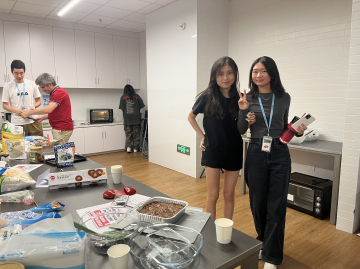
Note: the author is affiliated with this event.
Students pose as they are baking their energy bars in the school kitchen. Image from Dana K.
This week, from Thursday August 30 to Friday August 31, all the grade 11 students were split into small groups to work in a collaborative science project, also known as the DP Group 4 project. The task was to create a healthy energy bar, modeled to target the second UN sustainable development goal: zero hunger. In the groups of 4-5 people, there was at least one student from each of the IB science courses, which are biology, chemistry, physics, and environmental sciences. Participation was mandatory for all in the IB program, as this collaborative project is a requirement to receive the IB diploma.
Once the groups were made, students had to plan out what ingredients to use, how they were going to make the bar, which ingredients were the most nutritious, the amount of each ingredient, the estimated calories and macronutrients of each bar, and more. This took half of Thursday, spanning from noon to the end of school.
Hana M. commented on this aspect of collaboration, saying that it was a “really good learning experience for [her] because [she] was able to learn how to teamwork with people that [she has] never talked to.”
Similarly, Eddie L. said, “I learned that teamwork is a very important thing. You got to talk it out with your teammates and then divide the work between each other so that it works out well.”
Then, on Friday, students had the full day to create their bar, poster, and pamphlet to present to the judges at the end of the day. The “judges” included most of the school’s head administrators, which added onto the pressure for the students to do well.
By noon on Friday, most groups had already finished creating their energy bars. Every energy bar was unique, which showcased the originality and creativeness of the students.
The bars included a strawberry-flavored energy bar called “Pact”, a gut healthy bar called “Gutlicous”, a chia-seed based bar called “Chia-Chia”, and more. Every group had an original bar with an innovative name to it.
By the end of this project, everyone had learned something new. For example, Eddie L., who was in the group that supposedly added half a tub of protein powder to their batch, said, “I learned how to bake. I learned that we should not add protein powder into our granola bar.”
Katherine A. said that if she could do it again, she said she would “probably get [their] stuff more organized and order the ingredients that [they] need beforehand instead of running around the place trying to find [their] ingredients.”
Additionally, Travis H. reflected on his experience and said that he “would make the bar sweeter and not burn it” if he were to get a second chance.
While most people had a generally good time, others weren’t as optimistic. Carolina W. exclaimed that the project was “very overwhelming, unorganized, unsupervised and potentially unsafe” and that “we shouldn’t have to eat this.” As a side note, the ingredients used could not cause food poisoning, as no animal products were included and all of the ingredients could safely be eaten raw.
Towards the end, when everyone had presented their final product and all the judges came around to taste and judge each bar, the winner was announced, which was group 3. Their product name was “Pact”, and had a strawberry flavored energy bar, complete with handmade packaging for each individual bar.
![]()
The winning energy bar, Pact. Image from Sophie Z.
At the end of the day, students had the opportunity to work with people they had never worked with before, which ensued new connections and cooperation skills. The freedom to create any type of energy bar gave students a way to express their creativity and ingenuity. Even though it was mandatory, it was no doubt an enjoyable experience for most students.